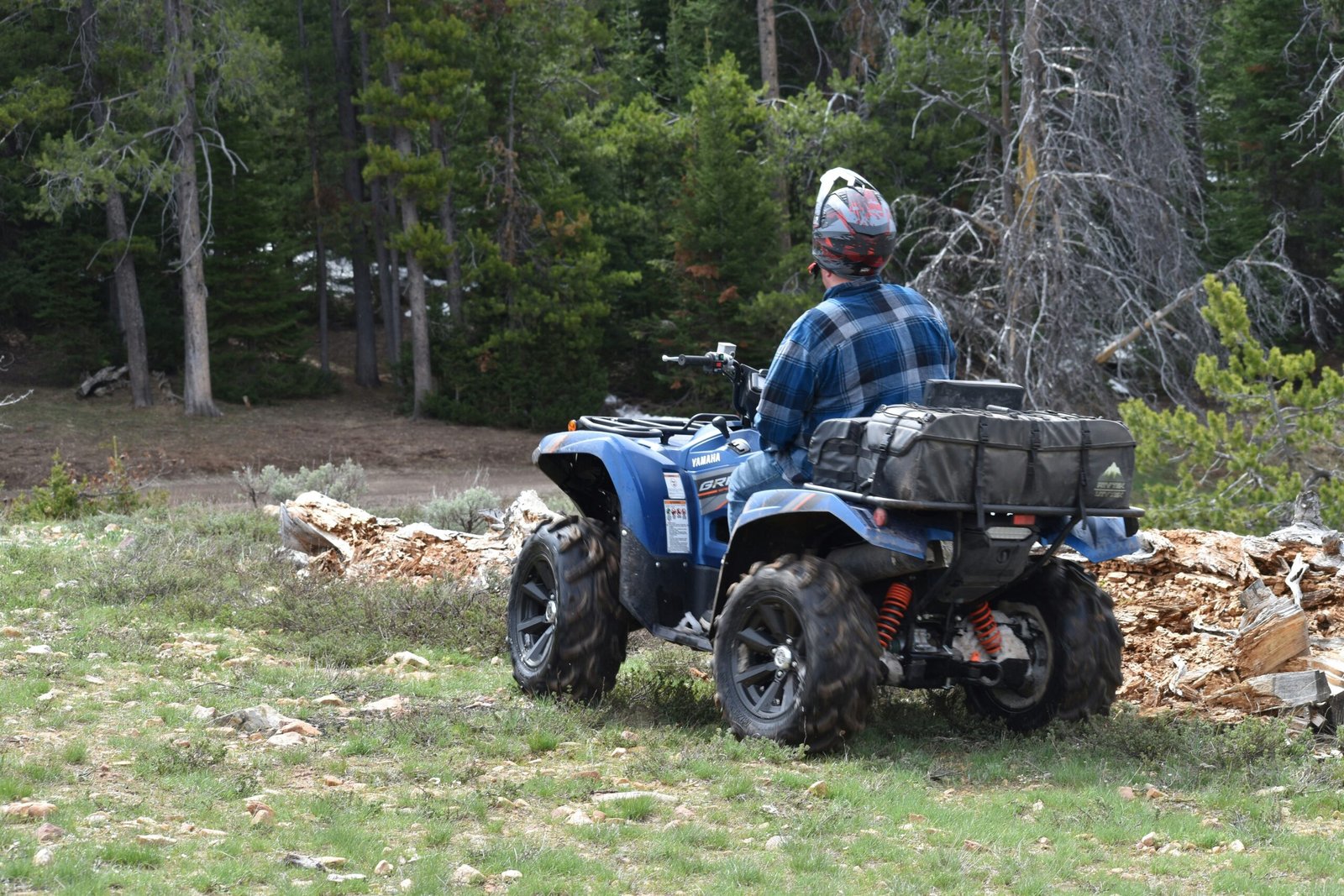Are you an ATV enthusiast looking to conquer rough terrains with ease? Look no further! In this article, we will share with you some proven tips and techniques that will help you maneuver through even the most challenging off-road trails on your ATV. From adjusting your body position to employing the right throttle control, these strategies will give you the confidence and skill to tackle any rough terrain that comes your way. So, fasten your seatbelts and get ready for a thrilling ATV adventure!

This image is property of images.unsplash.com.
Choosing the Right ATV
When it comes to mastering rough terrain on your ATV, choosing the right vehicle is crucial. One of the first factors to consider is the terrain you will be riding on. Different models of ATVs are designed for specific terrains, so it’s important to evaluate your needs and choose accordingly.
Evaluate the engine power of the ATV you are considering. The power of the engine determines how well the vehicle will perform in challenging terrain. If you plan on tackling steep hills and rough terrain, you will need an ATV with a more powerful engine to handle the demands.
Assessing the suspension system is another important aspect of choosing the right ATV. A good suspension system helps to absorb the shocks and vibrations that come from riding on rough terrain. Look for an ATV with a robust suspension system that can handle the bumps and dips along your ride.
Lastly, don’t underestimate the importance of good tires. A set of high-quality, durable tires can make a world of difference when it comes to maneuvering rough terrain. Look for tires with deep treads that provide excellent traction and stability.
Mastering Body Positioning
Once you have chosen the right ATV, it’s time to focus on mastering body positioning. Proper body positioning is essential for maintaining control and balance while riding on rough terrain.
Bend your knees to lower your center of gravity and provide stability. This will help you absorb impacts from bumps and keep you in control of your ATV. Additionally, leaning forward allows you to maintain a strong grip on the handlebars and improves your ability to steer accurately.
Always keep your feet on the footrests while riding. This provides stability and ensures that you are in control of the vehicle at all times. Avoid letting your legs dangle or drag, as this can compromise your balance and put you at greater risk of injury.
Distribute your weight properly on the ATV. This means leaning into turns and shifts in terrain, allowing your body to move with the vehicle. By distributing your weight properly, you can maintain balance and control, even in challenging situations.

This image is property of images.unsplash.com.
Using Proper Gear
Equipping yourself with the right gear is essential for your safety and comfort while riding rough terrain on your ATV. Here are some key pieces of gear to consider:
Wearing a helmet is a must. A helmet protects your head from impact and reduces the risk of severe head injuries in case of accidents.
Goggles or a face shield are crucial for protecting your eyes from dust, dirt, and debris on the trail. They also provide clear vision, allowing you to see obstacles ahead.
Choose sturdy boots that provide ankle support and protect your feet from impacts and injuries. Look for boots with a good grip to ensure stability while operating the ATV.
Layer your clothing to provide protection from the elements, as well as potential falls or scrapes. Consider wearing long pants, a long-sleeved shirt, and a durable riding jacket.
Opt for additional protective gear such as knee and elbow pads, chest protectors, and gloves. These items provide an extra layer of protection in case of accidents or falls.
Considering a chest protector can provide protection to your vital organs in case of accidents or flying debris on the trail.
Lowering Tire Pressure
Lowering the tire pressure on your ATV is a technique that can greatly improve your performance on rough terrain. Here are some benefits, precautions, and recommended tire pressure levels to consider.
Lowering the tire pressure can increase the contact patch between the tires and the ground, resulting in better traction and improved handling. This is especially useful when riding on loose or uneven surfaces.
However, it’s important to exercise caution when riding at low tire pressure. Running the tires at extremely low pressure can lead to increased wear and tear, and even cause damage to the tire or wheel. Always ensure that the tire pressure is within the manufacturer’s guidelines.
For most off-road ATV riding, a tire pressure of around 4 to 6 PSI is recommended. This allows for a good balance between traction and tire protection.

This image is property of images.unsplash.com.
Gaining Confidence in Slow Speeds
Confidence in slow speeds is essential when maneuvering through rough terrain. Practicing low-speed maneuvers will help build your skills and improve your overall control. Here are some techniques to consider:
Start by practicing basic low-speed maneuvers such as tight turns, figure eights, and navigating obstacles. This will help you become more familiar with the weight distribution of the ATV and how it handles at slower speeds.
Use the feathering technique when manipulating the throttle. This involves applying small bursts of throttle to maintain steady speed and control. Avoid sudden or excessive throttle inputs, as they can cause jerky movements and loss of control.
Maintain steady throttle control by keeping a consistent speed. This helps to provide stability and ensures that the ATV responds predictably to your inputs.
Avoid grabbing the brakes abruptly, especially in low-speed situations. Gradual and controlled braking is more effective and allows for better control of the ATV.
Learn controlled slide techniques. Controlled slides can help you navigate tight corners and maintain control on loose or slippery surfaces. Practice sliding the rear end of the ATV while maintaining control of the front wheels.
Braking Techniques
Braking is a fundamental skill that every ATV rider should master, especially when navigating rough terrain. Here are some techniques to help you brake effectively:
Use both brakes properly to maximize your stopping power. The front brake provides the majority of the stopping force, while the rear brake helps to stabilize the ATV. Use a balanced combination of both brakes for optimal braking performance.
Utilize the front brake responsibly. The front brake has a lot of stopping power, but it can also cause the ATV to nose dive and lose control if applied too abruptly or forcefully. Apply firm and gradual pressure on the front brake to avoid these issues.
Apply balanced braking to maintain stability and control. Distribute the braking force evenly between the front and rear brakes, using them simultaneously to maximize control and minimize the risk of skidding or flipping.
Avoid overusing the rear brake. Excessive use of the rear brake can cause the ATV to slide or fishtail, especially on loose terrain. Use the rear brake sparingly and combine it with the front brake for effective and controlled braking.
Master trail braking, which involves maintaining a light application of the brakes while navigating a turn. This technique helps to stabilize the ATV and maintain control throughout the turn.
Navigating Uphill and Downhill
Uphill and downhill sections can be some of the most challenging parts of riding on rough terrain. Here are some tips to help you navigate these situations with confidence:
Approach uphill slopes with momentum to carry you up the hill. Maintain a steady throttle and avoid sudden accelerations or decelerations that can cause the ATV to lose traction.
Choose a good line while climbing uphill. Look for the path of least resistance, avoiding large obstacles or loose terrain. Follow the trail of previous riders or choose a line with solid ground for better traction.
Use a low gear to climb uphill. This provides more torque and helps the ATV maintain power and control on steep slopes. Avoid shifting gears midway up a hill, as this can cause loss of traction and control.
Adjust your body position on downhill sections. Lean back to shift your center of gravity and improve stability. Keep your knees bent and shift your weight to the rear of the ATV, allowing the front wheels to have less weight on them.
Control your speed on descents by using the brakes effectively. Apply light and controlled braking to prevent the ATV from gaining too much speed. Use both the front and rear brakes in a balanced manner to maintain control.
Handling Obstacles
Riding through rough terrain means encountering various obstacles along the way. Here are some tips for navigating obstacles safely:
Spot obstacles in advance to prepare yourself mentally and physically. Look ahead on the trail and identify rocks, fallen branches, or other hazards that may pose a challenge.
Stand up on the footrests to absorb the impact when encountering obstacles. This helps to minimize the impact on your body and maintain control of the ATV.
Use proper body positioning while navigating obstacles. Lean forward to distribute your weight and maintain balance. Keep your head up and your eyes focused on the path ahead.
Maintain a steady speed when approaching and navigating obstacles. Abrupt changes in speed can make control more difficult and increase the risk of accidents.
Lean back on steep climbs to shift weight distribution and improve traction on the rear wheels. This helps to prevent the front end from tipping or losing traction.
Avoid overcorrecting if you encounter an obstacle. Quick and exaggerated steering inputs can lead to loss of control. Instead, make smooth and gradual adjustments when necessary.
Navigating Mud and Water
Riding through mud and water can be exhilarating but also challenging. Here are some tips for navigating these environments safely:
Maintain momentum when riding through mud. Keep a consistent speed to prevent your ATV from getting bogged down. This helps to maintain traction and keep you moving forward.
Choose a good line when riding through mud. Look for areas with slightly more solid ground or areas where previous riders have successfully passed. Avoid deep mud puddles that could potentially swallow your ATV or cause it to become stuck.
Avoid sudden acceleration when riding through mud. Gradual and controlled throttle inputs help to maintain traction and prevent excessive wheel spin or loss of control.
Prevent water from entering your ATV by avoiding deep water crossings. Deep water can damage the engine, electrical components, and other vital parts of your ATV. If you must cross water, do so cautiously and at a slow speed, ensuring that the water does not rise above the ATV’s recommended depth limit.
Safety Precautions
Safety should always be a top priority when riding an ATV. Here are some key safety precautions to keep in mind:
Ride with a buddy whenever possible. Having a riding partner increases safety and provides assistance in case of emergencies or breakdowns.
Inform others about your riding plan. Let someone know where you are going, how long you plan to be out, and when you expect to return. This way, if you do not return as scheduled, someone will be aware and can initiate a search if needed.
Check your ATV’s condition before riding. Ensure that all components are in good working order, including brakes, lights, tires, and controls. Regular maintenance and inspections are crucial for a safe and enjoyable ride.
Choose well-maintained trails for your rides. Look for trails that are regularly maintained, clearly marked, and safe for ATV riding. Avoid riding on private property or areas where ATV riding is prohibited.
Beware of hidden dangers on the trail. This includes rocks, fallen branches, tree stumps, and other obstacles that may not be immediately visible. Always ride cautiously and be prepared to react to unexpected hazards.
Carry essential safety gear, such as a first aid kit, a tool kit, a spare tire, and a communication device. These items can be lifesaving in case of emergencies or breakdowns.
Be alert and focused while riding. Avoid distractions such as using your phone or engaging in conversations that divert your attention from the trail. Stay focused on the terrain and be prepared to react to changing conditions.
By following these proven tips and techniques, you can maneuver rough terrain on your ATV with confidence and enjoy a safe and thrilling off-road adventure. Remember to choose the right ATV, master body positioning, use proper gear, lower tire pressure appropriately, gain confidence in slow speeds, brake effectively, navigate uphill and downhill sections, handle obstacles with care, navigate mud and water cautiously, and always prioritize safety. Happy riding!




